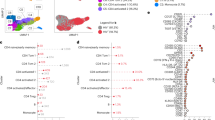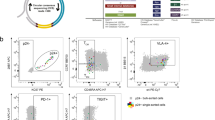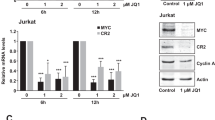Abstract
With combined antiretroviral therapy (cART), the risk for HIV-infected individuals to develop a non-Hodgkin lymphoma is diminished. However, the incidence of Burkitt lymphoma (BL) remains strikingly elevated. Most BL present a t(8;14) chromosomal translocation which must take place at a time of spatial proximity between the translocation partners. The two partner genes, MYC and IGH, were found colocalized only very rarely in the nuclei of normal peripheral blood B-cells examined using 3D-FISH while circulating B-cells from HIV-infected individuals whose exhibited consistently elevated levels of MYC-IGH colocalization. In vitro, incubating normal B-cells from healthy donors with a transcriptionally active form of the HIV-encoded Tat protein rapidly activated transcription of the nuclease-encoding RAG1 gene. This created DNA damage, including in the MYC gene locus which then moved towards the center of the nucleus where it sustainably colocalized with IGH up to 10-fold more frequently than in controls. In vivo, this could be sufficient to account for the elevated risk of BL-specific chromosomal translocations which would occur following DNA double strand breaks triggered by AID in secondary lymph nodes at the final stage of immunoglobulin gene maturation. New therapeutic attitudes can be envisioned to prevent BL in this high risk group.
This is a preview of subscription content, access via your institution
Access options
Subscribe to this journal
Receive 12 print issues and online access
$259.00 per year
only $21.58 per issue
Buy this article
- Purchase on SpringerLink
- Instant access to full article PDF
Prices may be subject to local taxes which are calculated during checkout







Similar content being viewed by others
References
Gibson TM, Morton LM, Shiels MS, Clarke CA, Engels EA . Risk of non-Hodgkin lymphoma subtypes in HIV-infected people during the HAART era: a population-based study. AIDS 2014; 28: 2313–2318.
Dolcetti R, Gloghini A, Caruso A, Carbone A . A lymphomagenic role for HIV beyond immune suppression? Blood 2016; 127: 1403–1409.
Shen X, Tomaras GD . Alterations of the B-cell response by HIV-1 replication. Curr HIV/AIDS Rep 2011; 8: 23–30.
Tsfasman TM, Klibi M, Pichugin AM, Lipinski M, Vassetzky YS . HIV: implication in Burkitt lymphoma. Biopolym Cell 2012; 28: 285–287.
Musinova YR, Sheval EV, Dib C, Germini D, Vassetzky YS . Functional roles of HIV-1 Tat protein in the nucleus. Cell Mol Life Sci 2015; 73: 589–601.
Marban C, Su T, Ferrari R, Li B, Vatakis D, Pellegrini M et al. Genome-wide binding map of the HIV-1 Tat protein to the human genome. PLoS One 2011; 6: e26894.
Reeder JE, Kwak Y-T, McNamara RP, Forst CV, D’Orso I . HIV Tat controls RNA Polymerase II and the epigenetic landscape to transcriptionally reprogram target immune cells. Elife 2015; 4: e08955.
Kundu RK, Sangiorgi F, Wu LY, Pattengale PK, Hinton DR, Gill PS et al. Expression of the human immunodeficiency virus-Tat gene in lymphoid tissues of transgenic mice is associated with B-cell lymphoma. Blood 1999; 94: 275–282.
Poggi A, Carosio R, Fenoglio D, Brenci S, Murdaca G, Setti M et al. Migration of V delta 1 and V delta 2T cells in response to CXCR3 and CXCR4 ligands in healthy donors and HIV-1-infected patients: competition by HIV-1 Tat. Blood 2004; 103: 2205–2213.
Taub R, Kirsch I, Morton C, Lenoir G, Swan D, Tronick S et al. Translocation of the c-myc gene into the immunoglobulin heavy chain locus in human Burkitt lymphoma and murine plasmacytoma cells. Proc Natl Acad Sci USA 1982; 79: 7837–7841.
Lieber MR . The mechanism of double-strand DNA break repair by the nonhomologous DNA end-joining pathway. Annu Rev Biochem 2010; 79: 181–211.
Nikiforova MN, Stringer JR, Blough R, Medvedovic M, Fagin JA, Nikiforov YE . Proximity of chromosomal loci that participate in radiation-induced rearrangements in human cells. Science 2000; 290: 138–141.
Roix JJ, McQueen PG, Munson PJ, Parada LA, Misteli T . Spatial proximity of translocation-prone gene loci in human lymphomas. Nat Genet 2003; 34: 287–291.
Sklyar I, Iarovaia OV, Gavrilov AA, Pichugin A, Germini D, Tsfasman T et al. Distinct patterns of colocalization of the CCND1 and CMYC genes with their potential translocation partner IGH at successive stages of B-cell differentiation. J Cell Biochem 2016; 117: 1506–1510.
Manic G, Maurin-Marlin A, Galluzzi L, Subra F, Mouscadet J-F, Bury-Moné S . 3′ self-inactivating long terminal repeat inserts for the modulation of transgene expression from lentiviral vectors. Hum Gene Ther Methods 2012; 23: 84–97.
Garcia JA, Harrich D, Pearson L, Mitsuyasu R, Gaynor RB . Functional domains required for tat-induced transcriptional activation of the HIV-1 long terminal repeat. EMBO J 1988; 7: 3143–3147.
Rossi C, Balboni PG, Betti M, Marconi PC, Bozzini R, Grossi MP . Inhibition of HIV-1 replication by a Tat transdominant negative mutant in human peripheral blood lymphocytes from healthy donors and HIV-1-infected patients. Gene Ther 1997; 4: 1261–1269.
Allinne J, Pichugin A, Iarovaia O, Klibi M, Barat A, Zlotek-Zlotkiewicz E et al. Perinucleolar relocalization and nucleolin as crucial events in the transcriptional activation of key genes in mantle cell lymphoma. Blood 2014; 123: 2044–2053.
Bou Saada Y, Dib C, Dmitriev P, Hamade A, Carnac G, Laoudj-Chenivesse D et al. Facioscapulohumeral dystrophy myoblasts efficiently repair moderate levels of oxidative DNA damage. Histochem Cell Biol 2016; 145: 475–483.
Merelli I, Guffanti A, Fabbri M, Cocito A, Furia L, Grazini U et al. RSSsite: a reference database and prediction tool for the identification of cryptic Recombination Signal Sequences in human and murine genomes. Nucleic Acids Res 2010; 38: 262–267.
Dion V, Gasser SM . Chromatin movement in the maintenance of genome stability. Cell 2013; 152: 1355–1364.
Iarovaia OV, Rubtsov M, Ioudinkova E, Tsfasman T, Razin SV . Dynamics of double strand breaks and chromosomal translocations. Mol Cancer 2014; 13: 249–258.
Xie A, Kwok A, Scully R . Role of mammalian Mre11 in classical and alternative nonhomologous end joining. Nat Struct Mol Biol 2009; 16: 814–818.
Dupré A, Boyer-Chatenet L, Sattler RM, Modi AP, Lee J-H, Nicolette ML et al. A forward chemical genetic screen reveals an inhibitor of the Mre11-Rad50-Nbs1 complex. Nat Chem Biol 2008; 4: 119–125.
Bertrand SJ, Aksenova MV, Mactutus CF, Booze RM . HIV-1 Tat protein variants: critical role for the cysteine region in synaptodendritic injury. Exp Neurol 2013; 248: 228–235.
Alt FW, Zhang Y, Meng FL, Guo C, Schwer B . Mechanisms of programmed DNA lesions and genomic instability in the immune system. Cell 2013; 152: 417–429.
Maizels N . Immunoglobulin gene diversification. Annu Rev Genet 2005; 39: 23–46.
Zhang M, Swanson PC . V(D)J recombinase binding and cleavage of cryptic recombination signal sequences identified from lymphoid malignancies. J Biol Chem 2008; 283: 6717–6727.
Pommier Y, Johnson AA, Marchand C . Integrase inhibitors to treat HIV/AIDS. Nat Rev Drug Discov 2005; 4: 236–248.
Melek M, Jones JM, O’Dea MH, Pais G, Burke TR, Pommier Y et al. Effect of HIV integrase inhibitors on the RAG1/2 recombinase. Proc Natl Acad Sci USA 2002; 99: 134–137.
Hicks C, Gulick RM . Raltegravir: the first HIV type 1 integrase inhibitor. Clin Infect Dis 2009; 48: 931–939.
Westendorp MO, Frank R, Ochsenbauer C, Stricker K, Dhein J, Walczak H et al. Sensitization of T cells to CD95-mediated apoptosis by HIV-1 Tat and gp120. Nature 1995; 375: 497–500.
Xiao H, Neuveut C, Tiffany HL, Benkirane M, Rich Ea, Murphy PM et al. Selective CXCR4 antagonism by Tat: implications for in vivo expansion of coreceptor use by HIV-1. Proc Natl Acad Sci USA 2000; 97: 11466–11471.
Bibas M, Antinori A . EBV and HIV-related lymphoma. Mediterr J Hematol Infect Dis 2009; 1: e2009032.
Lieber MR . Mechanisms of human lymphoid chromosomal translocations. Nat Rev Cancer 2016; 16: 387–398.
Pantaleo G, Graziosi C, Demarest JF, Butini L, Montroni M, Fox CH et al. HIV infection is active and progressive in lymphoid tissue during the clinically latent stage of disease. Nature 1993; 362: 355–358.
Acknowledgements
We thank the National Institutes of Health AIDS Research and Reference Reagent Program for supplying critical reagents. This work was supported by grants from the ANRS to YV and TT; INSERM (ENVIBURKITT) to YV; the Russian Science Foundation #14-24-00022 to SR and OI and #14-15-00199 to YV.
Author contributions
ML, YV conceived and designed the study. DG, TT, MK, AP and REA designed and performed 3D-FISH experiments. DG and TT acquired and analyzed microscopic images, and interpreted the data. FS and SBM conceived HIV-1 experiments and analyzed the data. REA and YBS performed DNA damage experiments. AS analyzed the gene and protein expression data. DB and EO provided patients clinical data and samples. CBN performed cytogenetic analyses. MR, OI and SR critically interpreted the data. ML, DG, TT, EO, JW and YV wrote the manuscript.
Author information
Authors and Affiliations
Corresponding authors
Ethics declarations
Competing interests
The authors declare no conflict of interest.
Additional information
Supplementary Information accompanies this paper on the Leukemia website
Rights and permissions
About this article
Cite this article
Germini, D., Tsfasman, T., Klibi, M. et al. HIV Tat induces a prolonged MYC relocalization next to IGH in circulating B-cells. Leukemia 31, 2515–2522 (2017). https://doi.org/10.1038/leu.2017.106
Received:
Revised:
Accepted:
Published:
Issue Date:
DOI: https://doi.org/10.1038/leu.2017.106



